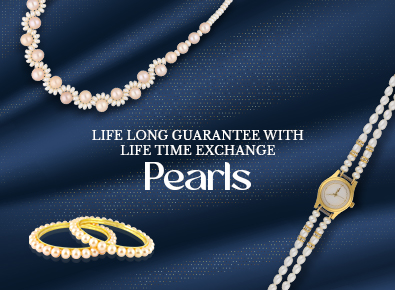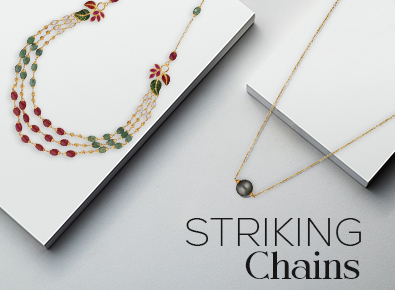Diamond Education & Guide
If you are planning on purchasing a diamond, it is important that you know as much as possible about how diamonds are classified as the cost of a diamond is determined by the 4 C’s which are the top most criteria one needs to become familiar with – Cut, Color, Clarity and Carat Weight. Our Diamond guide should help you answer all the questions and pick up the perfect diamond.
SHAPE
The high quality standards that we adhere to at Jpearls are the same in all our diamond shapes. With an exceptional collection of traditional round diamonds along with the finest non-round, or ‘fancy-shaped’ diamonds, Jpearls offers a wide selection to choose from. Each shape specifically appeals to an individual or personal taste, each one is also meticulously and systematically cut to highlight the diamond’s best features and bring out its brilliance. Following is a guide of the various shape options available and an introduction to each shape, including information on how to determine the best combination of size, color, and clarity to suit your needs.
CUT
Cut is a diamond’s most important characteristic and has the greatest overall influence on a diamond’s beauty and sparkle. A diamond’s cut grade is an objective measure of a diamond’s light performance, or, what we generally think of as sparkle. When a diamond is cut with the proper proportions, light is returned out of the top of the diamond (which gemologists refer to as the table). If it is cut too shallow, light leaks out of the bottom; too deep and it escapes out of the side.
Cut Grades:
- Ideal cut: Represents roughly the top 3% of diamond quality based on cut. Reflects nearly all light that enters the diamond. An exquisite and rare cut.
- Very good cut: Represents roughly the top 15% of diamond quality based on cut. Reflects nearly as much light as the ideal cut, but for a lower price.
- Good cut: Represents roughly the top 25% of diamond quality based on cut. Reflects most light that enters. Much less expensive than a very good cut.
- Fair cut: Represents roughly the top 35% of diamond quality based on cut. Still a quality diamond, but a fair cut will not be as brilliant as a good cut.
- Poor cut: Diamonds that are generally so deep and narrow or shallow and wide that they lose most of the light out the sides and bottom.
CLARITY
Clarity is one of the fundamental attributes of a diamond and it is determined by the size, number position and nature of the inclusions, or internal characteristics of a stone. The fewer inclusions or blemishes there are in or on the diamond, the higher the clarity grade and therefore value. The type of inclusions that affect the clarity can include scratches, blemishes, and pockets of air or non-diamond material inside or on the surface of a stone
Flawless or Internally Flawless: FL or IF
Flawless and Internally Flawless certified diamonds are extremely rare. The difference between the two is that internally flawless diamonds (IF), like the FL, are 100% flawless from the inside but IF diamonds will contain surface graining on the outside. These are not technically considered a flaw, but consist in the only point of differentiation between the extremely rare Flawless and the very rare IF clarity grades
Very Very Slightly Included 1: VVS1
A diamond of this clarity grade would have one tiny inclusion that can only be located using a powerful microscope. This clarity grade guarantees that the inclusion is invisible even under a 10x magnification loupe. This clarity grade is almost as rare as the IF clarity and as such is highly regarded although not quite as expensive.
Very Very Slightly Included 2: VVS2
These diamonds would only have two tiny inclusions and consistent with the VVS1 grading only a microscope would identify inclusions. However, expert graders may be able to locate a VVS2 inclusion using a 10x magnification loupe but VVS2 still offer a very high level of clarity and are less expensive price than a VVS1.
Very Slightly Included 1: VS1
VS1 diamonds have one small or a few very tiny inclusions that are not visible to the unaided eye (eye clean) and can only be located, often with difficulty, using a 10x magnification loupe. VS1 clarity diamonds are an excellent choice as they are still eye-clean whilst being less expensive than the VVS categories.
Slightly Included 1: SI1
SI1 graded diamonds have two medium or many small inclusions that will almost always be visible to the unaided eye and are easy to locate using a 10x magnification loupe. Depending on how well placed and lightly coloured the inclusions are the stones can appear almost eye clean and therefore SI1 clarity diamonds can offer exceptional value for those wishing to maximise their budget. An SI1 diamond on a GIA, HRD or AGS certificate will in over 50% of cases be eye clean depending on the chosen shape. However, as with the VVS2, this grade of diamonds probably won’t be eye clean on Emerald and Asscher cuts, on any certificate.
Slightly Included 2: SI2
SI2 diamonds have a greater number of inclusions that will almost always be visible to the unaided eye. As with the SI1 clarity diamonds, they can offer great value for money and depending on the inclusions it can be possible to find an eye clean stone at a fraction of the price of higher clarity grades.
I1 or lower
These diamonds will always have inclusions clearly visible to the naked eye, even on the strictest certificates, such as those of the GIA. Even though it is still possible for us to source such diamonds upon request, we would recommend choosing SI2 clarity diamonds or above.
CARAT
Carat is specifically a measure of a diamond’s weight, and by itself may not accurately reflect a diamond’s size.To understand diamond size, carat weight should be considered in conjunction with two other criteria:
– Distance in millimeters across the top of the diamond.
– Diamond’s cut grade.
The term carat originates from the Greek and Arabic names for the carob tree – Keration in Greek and Qirrat in Arabic. The dried seeds of the Carob (or Locust) tree were once widely used by trading merchants as counterweights for weighing gold, diamonds, gemstones and pearls due to their relatively consistent weight and size. It is important to note however, that the term “carat” with reference diamonds is different to “karat” which is the value used for the purity of gold.
A diamond’s cut grade should also be considered because, as we noted in the cut grade section, when a diamond is cut with the proper proportions, the maximum amount of light (or sparkle) is returned out of the top of the diamond. Thus, when a diamond is well cut, the light reflected out of the top makes it appear larger. In addition, much of the weight of a poorly cut diamond, for example, may be “hidden” in the base of the diamond, making the diamond appear smaller than its carat weight would imply.
It is therefore possible to have a diamond of a lower carat weight, but higher cut grade that appears larger than a diamond with a larger carat weight, but poor cut.
Once you’ve selected your cut, color, and clarity grade, it’s easy to determine the carat weight of diamond that will fit within your budget.
CERTIFICATION
Before purchasing a diamond, you should expect to review a copy of its certificate as proof that it has undergone an unbiased, professional examination.
What is a Certificate?
A diamond certificate is issued following an unbiased and professional examination to authenticate a diamond’s attributes. The carat weight, colour and clarity are all validated, together with the diamond’s exact measurements. Cut grades are also included for Round Brilliant cuts. Certificates are essential in determining or testifying a diamond’s value. Diamonds sold through Seventy Seven Diamonds have been graded by GIA, AGS, HRD, IGI, EGL (International or USA). It is generally accepted by diamond industry professionals that the Gemological Institute of America (GIA) sets the standard when it comes to diamond grading. At least three-quarters of the 200,000 diamonds listed on Seventy Seven Diamonds have been graded by the GIA.
ROUND BRILLIANT
Clean, classic, versatile and with more fire and brilliance than any other shape, it would be difficult to persuade anyone against this choice—as proven by the fact that it accounts for more than half of all diamonds sold today. The round brilliant cut diamond is by far the most popular and most researched diamond shape available today. To maximize the brilliance of a traditional round diamond, select one in the two highest cut grades, ideal or very good, and choose ideal, excellent, or very good polish and symmetry grades.
EMERALD
Speaking volumes of vintage glamour and old world charm, and favoured by such style icons as Grace Kelly and Jackie O, the emerald cut was one of the first cuts to be used in jewellery design, and with its broad flat plane highlights the clarity and natural crystalline growth of a diamond to unparalleled measure. What makes this shape different is its pavilion, which is cut with rectangular facets to create a unique optical appearance. Due to its larger, open table, this shape highlights the clarity of a diamond. For the classic emerald-cut shape, look for a length-to-width ratio between 1.30 and 1.40.
PEAR
Infamously given to Elizabeth Taylor by two-time-husband Richard Burton, the pear, or teardrop as it is sometimes called, is a unique and feminine shape with one rounded and one pointed end that makes for a delicate and stunning choice. If you choose an elongated pear shape, the length of the diamond creates a subtle slimming effect on the fingers. For the most traditional pear-shaped diamond, look for a length-to-width ratio between 1.45 and 1.75.
OVAL
Somewhere in between the round brilliant and the pear shape, the oval cut is the perfect choice if you’re wishing to savour the sparkle of the round brilliant in a slightly rarer and more elongated form. Oval diamonds are also very popular as their length can accentuate long, slender fingers. For the most traditional oval diamonds, look for length-to-width ratios between 1.33 and 1.66.
HEART
Ever the romantic choice, this rare and symbolic cut is the ideal way to wear your heart on your finger, not your sleeve, and there is surely no better way to be in love and in style all at once. For a more traditional heart-shaped diamond, look for length-to-width ratios between .90 and 1.10.
PRINCESS
Much like the round brilliant, the Princess cut is a classic and elegant shape, although with its sharp corners boasts more of a contemporary edge. This shape is ideal way to capture the brilliance and simple elegance of the round and still be trendy. For a princess diamond shape that is square, look for length-to-width ratios between 1 and 1.05. If you prefer more of a rectangular shape, look for length-to-width ratios greater than 1.10
ASSCHER
Replete with timeless elegance and Art-Deco cool, the Asscher cut is a rectangular shape similar to the more well-known emerald cut, with prismatic brilliance, tremendous luster and a fascinating optical illusion known as the “Hall of Mirrors” effect.The modern Asscher cut diamond is usually with larger step facets, a higher crown, and a smaller table. This combination often produces more brilliance than the emerald cut.The classic Asscher cut diamond is a square with a length to width ratio of 1.00), also often found in slightly rectangular shapes as well. Any ratio of 1.05 or less will appear square to the naked eye.
RADIANT
A square- or rectangular-shaped hybrid cut that combines the brilliance and depth of the round, emerald and princess cuts, the radiant is the most brilliant of all the squared shapes making it both a beautiful and dramatic choice. A radiant-cut looks equally beautiful set with either baguette or round side-diamonds. Radiant-cut diamonds can vary in their degree of rectangularity. For a radiant diamond shape that is square, look for length-to-width ratios between 1 and 1.05.
CUSHION
As its name suggests, the cushion cut is a square or rectangular shape with rounded corners, resembling a pillow shape. One of the rarer and more unique choices, the cushion cut’s large facets allow for great light dispersion, giving birth to a much larger range of spectral colours and making for a highly scintillating stone. Cushion-cut diamonds are available in shapes ranging from square to rectangular. For a cushion-cut diamond that is square, look for length-to-width ratios between 1 and 1.05.
MARQUISE
Originally commissioned in 18th century Paris by King Louis XV to emulate the smile of his mistress the Marchioness Madame de Pompadour, the Marquise harkens back to the glory of the age d’or, and is also an ideal way to optimise carat weight and elongate the finger. For the most traditional marquise-cut diamonds, look for length-to-width ratios between 1.75 and 2.25.
One of the most defining characteristics of a diamond is its cut. While high grades of color, clarity, and carat weight also contribute to a diamond’s appeal, it’s the cut that determines the symmetry of the stone’s facets, its overall proportions, and its ability to reflect light. An expertly cut diamond will achieve high levels of brilliance, sparkle, and durability. Even if a diamond is graded well in other areas, a poor cut can result in a dull, muted effect.







